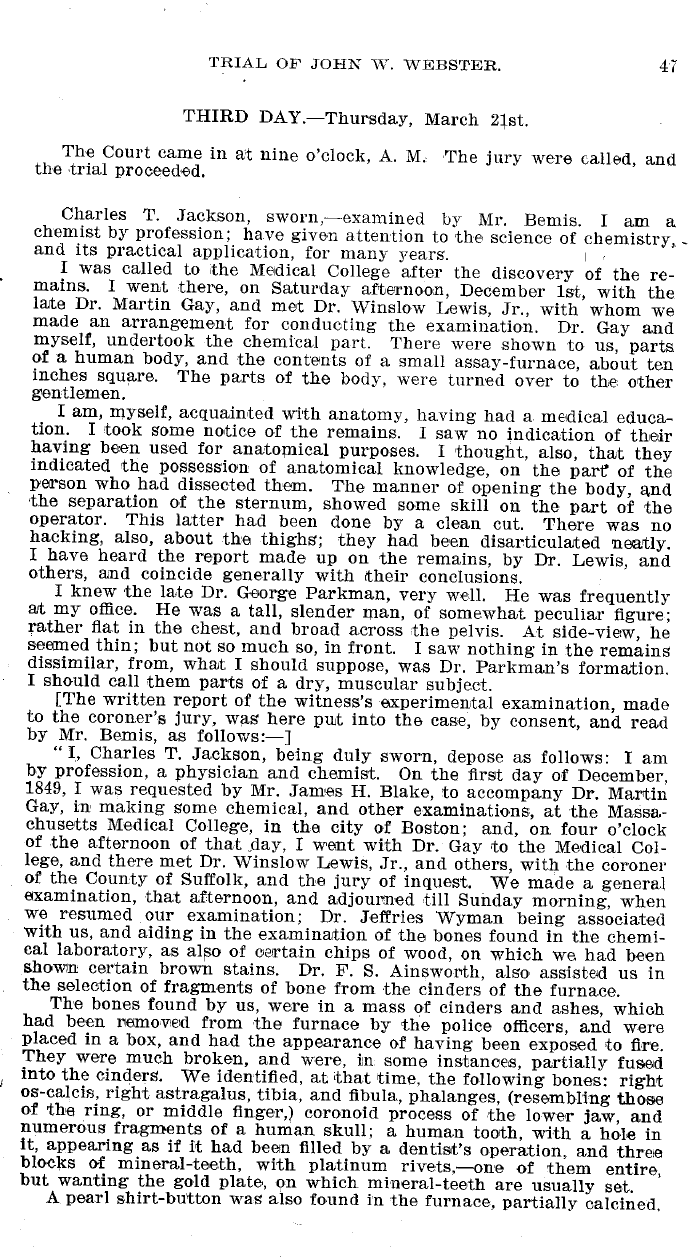|
TRIAL OF JOHN W. WEBSTER. 4!
THIRD DAY.-Thursday, March 21st.
The Court came in at nine o'clock, A. M: The jury were called, and
the trial proceeded.
Charles T. Jackson, sworn, examined by Mr. Bemis.I am a
chemist by profession; have giver, attention to the science of chemistry,
and its practical application, for many years. i
I was called to the Medical College after the discovery of the re-
mains. I went there, on Saturday afternoon, December 1st, with the
late Dr. Martin Gay, and met Dr. Winslow Lewis, Jr., with whom we
made an arrangement for conducting the examination. Dr. Gay and
myself, undertook the chemical part. There were shown to us, parts
of a human body, and the contents of a small assay-furnace, about ten
inches square. The parts of the body, were turned over to the: other
gentlemen.
I am, myself, acquainted with anatomy, having had a. medical educa-
tion. I took some notice of the remains. I saw no indication of th~elir
having been used for anatomical purposes. I thought, also, that they
indicated 'the possession of anatomical knowledge, on the part of the
person who had dissected them. The manner of opening the body, and
the separation of the sternum, showed some skill on the part of the
operator. This latter had been done by a clean cut. There was no
hacking, also, about the thighs; they had been disarticulatted neatly.
I have heard the report made up on the remains, by Dr. Lewis, and
others, and coincide generally with their conclusions.
I knew the late Dr. George Parkman, very well. He was frequently
att my office. He was a tall slender man, of somewhat peculiar figure;
rather flat in the chest, and broad across the pelvis. At side-view, he
seemed thin; but not so much so, in front. I saw nothing in the remains
dissimilar, from, what I should suppose, was Dr. Parkman's formation.
I should call them parts of a dry, muscular subject.
[The written report of the witness's experimental examination, made
to the coroner's jury, was here put into the case, by consent, and read
by Mr. Bemis, as follows:-]
" I, Charles T. Jackson, being duly sworn, depose as follows: I am
by profession, a physician and chemist. On the first day of December,
1849, I was requested by Mr. James H. Blake, to accompany Dr. Martin
Gay, in making some chemical, and other examinations, at the Massa-
chusetts Medical College, in the city of Boston; and, on four o'clock
of the afternoon of that day, I went with Dr. Gay to the Medical Col-
lege, and there met Dr. Winslow Lewis, Jr., and others, with the coroner
of the County of Suffolk, and the jury of inquest. We made a general
examination, that afternoon, and adjourned till Sunday morning, when
we resumed our examination; Dr. Jeffries Wyman being associated
with us, and aiding in the examination of the bones found in the chemi-
cal laboratory, as also of certain chips of wood, on which we had been
shown certain brown stains. Dr. F. S. Ainsworth, also assisted us in
the selection of fragments of bone from the cinders of the furnace.
The bones found by us, were in a mass of cinders and ashes which
had been removed from the furnace by the police officers, and were
placed in a box, and had the appearance of having been exposed to fire.
They were much broken, and were, in some instances, partially fused
into the cinders. We identified, at that time, the following bones: right
os-calcis, right astragalus, tibia, and fibula, phalanges, (resembling those
of the ring, or middle finger,) coronoid process of the lower jaw, and
numerous fragments of a human skull; a human tooth, with a hole in
it, appearing as if it had been filled by a dentist's operation, and three
blocks of mineral-teeth, with platinum rivets,-one of them entire,
but wanting the gold plate, on which mineral-teeth are usually set.
A pearl shirt=button was also found in the furnace, partially calcined,
|

